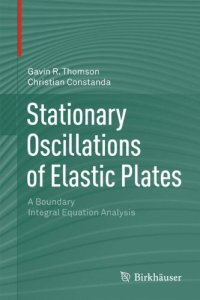
Ebook: Stationary Oscillations of Elastic Plates: A Boundary Integral Equation Analysis
- Tags: Integral Equations, Vibration Dynamical Systems Control, Mathematical Methods in Physics, Partial Differential Equations
- Year: 2011
- Publisher: Birkhäuser Basel
- Edition: 1
- Language: English
- pdf
Elliptic partial differential equations are important for approaching many problems in mathematical physics, and boundary integral methods play a significant role in their solution. This monograph investigates the latter as they arise in the theory characterizing stationary vibrations of thin elastic plates. The techniques used reduce the complexity of classical three-dimensional elasticity to a system of two independent variables, using eigenfrequencies to model problems with flexural-vibrational elastic body deformation and simplifying these problems to manageable, uniquely solvable integral equations.
In under 250 pages, Stationary Oscillations of Elastic Plates develops an impressive amount of theoretical machinery. After introducing the equations describing the vibrations of elastic plates in the first chapter, the book proceeds to explore topics including
- the single-layer and double-layer plate potentials;
- the Newtonian potential;
- the exterior boundary value problems;
- the direct boundary integral equation method;
- the Robin boundary value problems;
- the boundary-contact problem;
- the null field equations.
Throughout, ample time is allotted to laying the groundwork necessary for establishing the existence and uniqueness of solutions to the problems discussed.
The book is meant for readers with a knowledge of advanced calculus and some familiarity with functional analysis. It is a useful tool for professionals in pure and applied mathematicians, as well as for theoretical physicists and mechanical engineers with practices involving elastic plates. Graduate students in these fields would also benefit from the monograph as a supplementary text for courses relating to theories of elasticity or flexural vibrations.
Many problems in mathematical physics rely heavily on the use of elliptical partial differential equations, and boundary integral methods play a significant role in solving these equations. Stationary Oscillations of Elastic Plates studies the latter in the context of stationary vibrations of thin elastic plates. The techniques presented here reduce the complexity of classical elasticity to a system of two independent variables, modeling problems of flexural-vibrational elastic body deformation with the aid of eigenfrequencies and simplifying them to manageable, uniquely solvable integral equations. The book is intended for an audience with a knowledge of advanced calculus and some familiarity with functional analysis. It is a valuable resource for professionals in pure and applied mathematics, and for theoretical physicists and mechanical engineers whose work involves elastic plates. Graduate students in these fields can also benefit from the monograph as a supplementary text for courses relating to theories of elasticity or flexural vibrations.